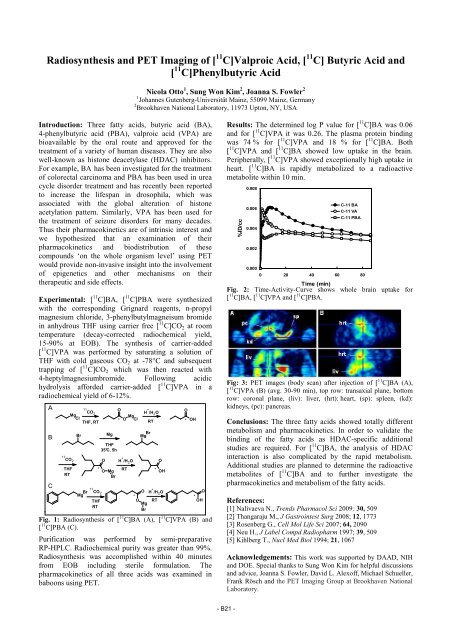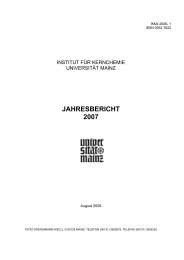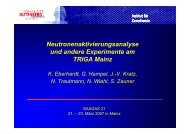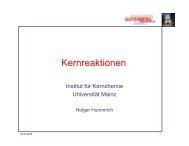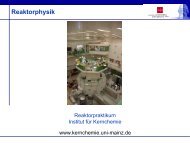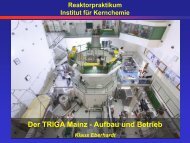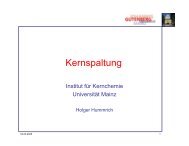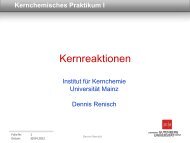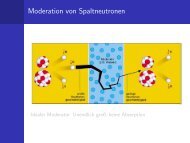institut für kernchemie universität mainz jahresbericht 2009
institut für kernchemie universität mainz jahresbericht 2009
institut für kernchemie universität mainz jahresbericht 2009
You also want an ePaper? Increase the reach of your titles
YUMPU automatically turns print PDFs into web optimized ePapers that Google loves.
Radiosynthesis and PET Imaging of [ 11 C]Valproic Acid, [ 11 C] Butyric Acid and<br />
[ 11 C]Phenylbutyric Acid<br />
Introduction: Three fatty acids, butyric acid (BA),<br />
4-phenylbutyric acid (PBA), valproic acid (VPA) are<br />
bioavailable by the oral route and approved for the<br />
treatment of a variety of human diseases. They are also<br />
well-known as histone deacetylase (HDAC) inhibitors.<br />
For example, BA has been investigated for the treatment<br />
of colorectal carcinoma and PBA has been used in urea<br />
cycle disorder treatment and has recently been reported<br />
to increase the lifespan in drosophila, which was<br />
associated with the global alteration of histone<br />
acetylation pattern. Similarly, VPA has been used for<br />
the treatment of seizure disorders for many decades.<br />
Thus their pharmacokinetics are of intrinsic interest and<br />
we hypothesized that an examination of their<br />
pharmacokinetics and biodistribution of these<br />
compounds ‘on the whole organism level’ using PET<br />
would provide non-invasive insight into the involvement<br />
of epigenetics and other mechanisms on their<br />
therapeutic and side effects.<br />
Experimental: [ 11 C]BA, [ 11 C]PBA were synthesized<br />
with the corresponding Grignard reagents, n-propyl<br />
magnesium chloride, 3-phenylbutylmagneisum bromide<br />
in anhydrous THF using carrier free [ 11 C]CO2 at room<br />
temperature (decay-corrected radiochemical yield,<br />
15-90% at EOB). The synthesis of carrier-added<br />
[ 11 C]VPA was performed by saturating a solution of<br />
THF with cold gaseous CO2 at -78°C and subsequent<br />
trapping of [ 11 C]CO2 which was then reacted with<br />
4-heptylmagnesiumbromide. Following acidic<br />
hydrolysis afforded carrier-added [ 11 C]VPA in a<br />
radiochemical yield of 6-12%.<br />
A<br />
B<br />
C<br />
11 O<br />
CO2 H + /H2O Mg<br />
Cl<br />
THF, RT<br />
O Mg * Cl<br />
Br Mg Br<br />
Mg<br />
11<br />
CO2 +<br />
O H /H2O THF<br />
RT<br />
Mg Br<br />
11<br />
CO2<br />
THF<br />
RT<br />
THF<br />
35°C, 5h<br />
*<br />
O Mg<br />
Br<br />
RT<br />
*<br />
Nicola Otto 1 , Sung Won Kim 2 , Joanna S. Fowler 2<br />
1 Johannes Gutenberg-Universität Mainz, 55099 Mainz, Germany<br />
2 Brookhaven National Laboratory, 11973 Upton, NY, USA<br />
RT<br />
O<br />
OH<br />
O<br />
* OH<br />
O H O<br />
O OH<br />
Mg<br />
Br<br />
+ /H2O * *<br />
RT<br />
Fig. 1: Radiosynthesis of [ 11 C]BA (A), [ 11 C]VPA (B) and<br />
[ 11 C]PBA (C).<br />
Purification was performed by semi-preparative<br />
RP-HPLC. Radiochemical purity was greater than 99%.<br />
Radiosynthesis was accomplished within 40 minutes<br />
from EOB including sterile formulation. The<br />
pharmacokinetics of all three acids was examined in<br />
baboons using PET.<br />
Results: The determined log P value for [ 11 C]BA was 0.06<br />
and for [ 11 C]VPA it was 0.26. The plasma protein binding<br />
was 74 % for [ 11 C]VPA and 18 % for [ 11 C]BA. Both<br />
[ 11 C]VPA and [ 11 C]BA showed low uptake in the brain.<br />
Peripherally, [ 11 C]VPA showed exceptionally high uptake in<br />
heart. [ 11 C]BA is rapidly metabolized to a radioactive<br />
metabolite within 10 min.<br />
%ID/cc<br />
0.008<br />
0.006<br />
0.004<br />
0.002<br />
0.000<br />
C-11 BA<br />
C-11 VA<br />
C-11 PBA<br />
0 20 40 60 80<br />
Fig. 2: Time-Activity-Curve shows whole brain uptake for<br />
[ 11 C]BA, [ 11 C]VPA and [ 11 Time (min)<br />
C]PBA.<br />
Fig: 3: PET images (body scan) after injection of [ 11 C]BA (A),<br />
[ 11 C]VPA (B) (avg. 30-90 min), top row: transaxial plane, bottom<br />
row: coronal plane, (liv): liver, (hrt): heart, (sp): spleen, (kd):<br />
kidneys, (pc): pancreas.<br />
Conclusions: The three fatty acids showed totally different<br />
metabolism and pharmacokinetics. In order to validate the<br />
binding of the fatty acids as HDAC-specific additional<br />
studies are required. For [ 11 C]BA, the analysis of HDAC<br />
interaction is also complicated by the rapid metabolism.<br />
Additional studies are planned to determine the radioactive<br />
metabolites of [ 11 C]BA and to further investigate the<br />
pharmacokinetics and metabolism of the fatty acids.<br />
References:<br />
[1] Nalivaeva N., Trends Pharmacol Sci <strong>2009</strong>; 30, 509<br />
[2] Thangaraju M., J Gastrointest Surg 2008; 12, 1773<br />
[3] Rosenberg G., Cell Mol Life Sci 2007; 64, 2090<br />
[4] Neu H., J Label Compd Radiopharm 1997; 39, 509<br />
[5] Kihlberg T., Nucl Med Biol 1994; 21, 1067<br />
Acknowledgements: This work was supported by DAAD, NIH<br />
and DOE. Special thanks to Sung Won Kim for helpful discussions<br />
and advice, Joanna S. Fowler, David L. Alexoff, Michael Schueller,<br />
Frank Rösch and the PET Imaging Group at Brookhaven National<br />
Laboratory.<br />
- B21 -


